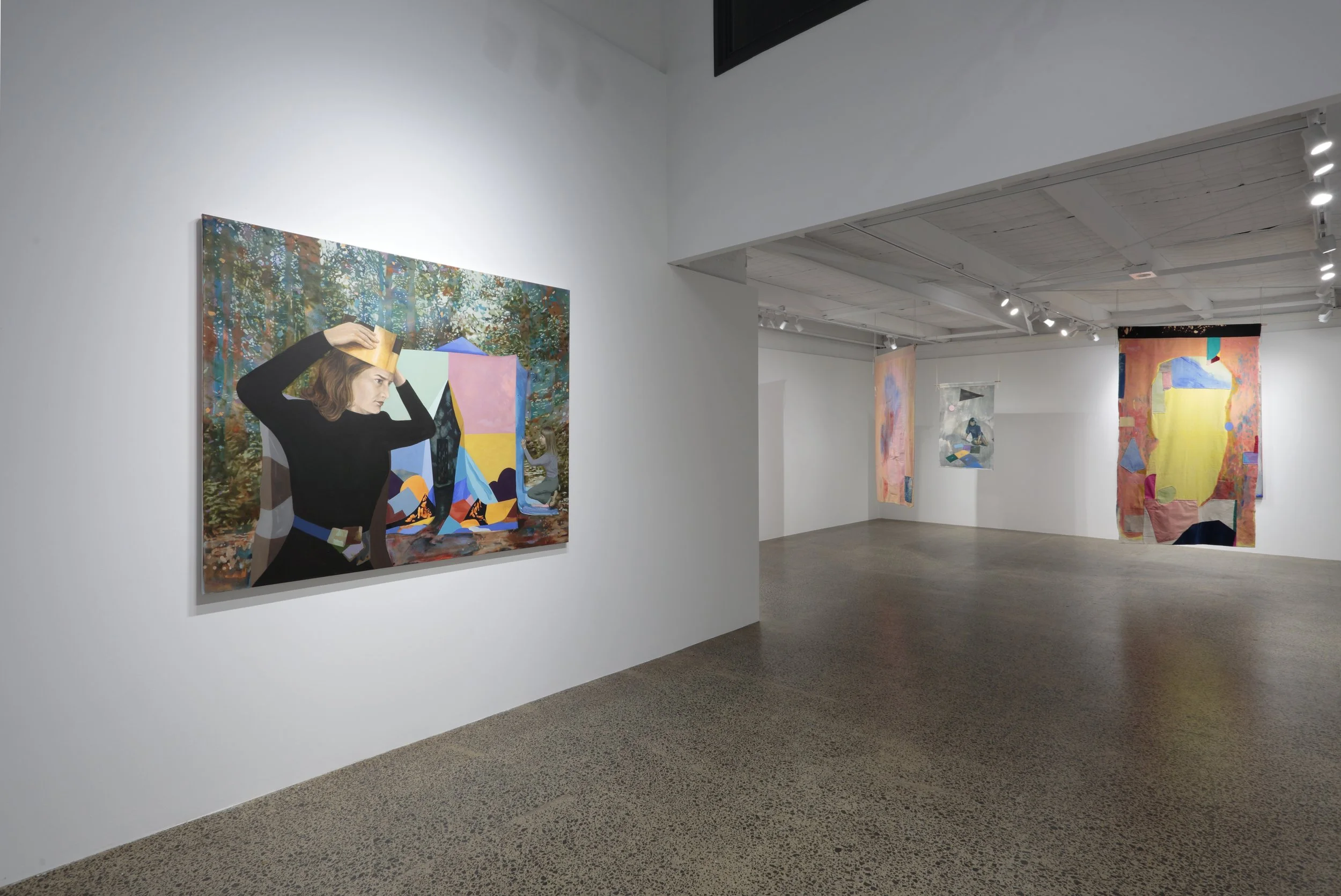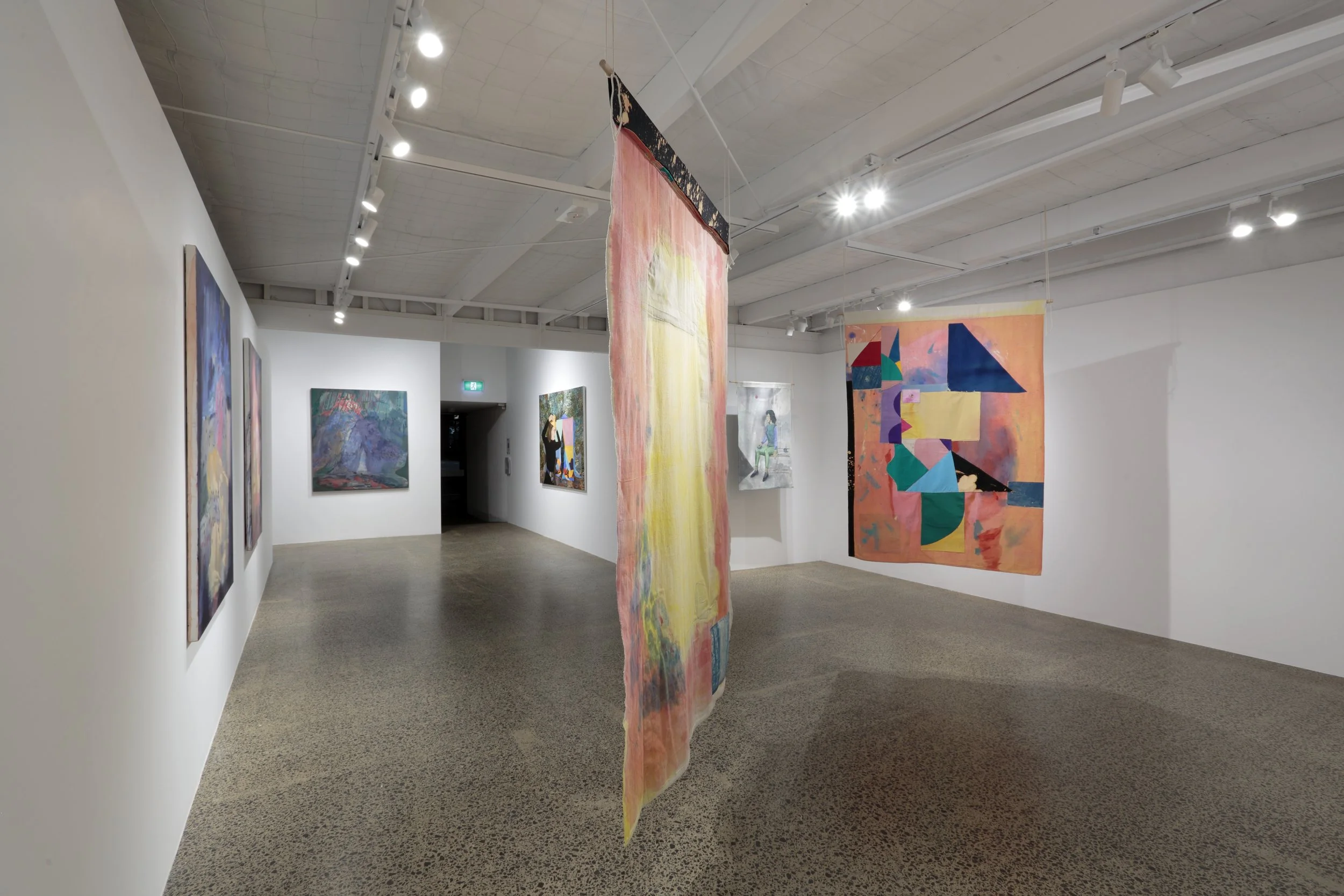The Heroine Paint: Kylie Banyard & Amber Wallis
Lismore Regional Gallery (11 July to 1 August 2021)
Nicholas Thompson Gallery, Melbourne (29 June to 17 July 2021)
EXHIBITION ESSAY
The Heroine Paint brings together the work of Kylie Banyard and Amber Wallis, highlighting their visions of painterly utopia. The artists pay homage to American Abstract Expressionism of the 1940s and 50s, which rejected representational norms within art and painting. Spontaneity stood at the centre of this, and a purist’s distillation of materials. The counterculture of the 1960s and 70s, which had similar aspirations to breakdown boundaries and initiate change, is also present in both artists’ work. Despite intentions for a new agenda that went with these movements, power remained largely patriarchal. Women have continued to be marginalised by this status quo. The Heroine Paint reconfigures this inequity to the advantage of women.
Kylie Banyard draws on Black Mountain College’s (1933-1957) photographic archive to realise lived and imagined narratives. Based in the picturesque mountains of North Carolina, the College had a non-hierarchical structure and students and teachers lived side-by-side. In addition to their education in art, design, architecture, theatre, costume, and the written word, students grew food, worked the land, cooked and ate together, and participated in construction projects. Tasks of the day were all artful and of equal importance. It was a community where art, life and education were intertwined.
The photographic archive that Banyard has used documents what was happening at the college. It shows that women were not only present, they were active in all aspects of college life. However, as careers progressed it was evident that the art world and market still favoured men. There were female students at the school who gained recognition, and Ruth Asawa, Susan Weil and Elaine de Kooning were among them, however their reputations do not match those of the men. Josef Albers, Robert Motherwell, Cy Twombly, Robert Rauschenberg, Franz Kline and Willem de Kooning are some major names associated with Black Mountain.
In Banyard’s work, canvas (the heroic material that was used by American Abstract Expressionists as a field for colour and form and expanded to macho proportions) connects the work to the history of painting. However, the material also links to the feminine. The large spans of fabric connote the American tradition of quilting and ‘women’s craft’.
The repositioning of the historical images invites us to look towards an alternative future. Women are strong and capable protagonists, working outdoors and using their hands to make art, tend fields and build alternative futures. Banyard has long been interested in intentional communities, and she has choreographed one that presents women in ways that appear nurturing, cooperative and non-combative. In highlighting these traits that are often associated with women, she brings a shifted lens to what is valuable.
Amber Wallis is similarly drawn to reimagining the utopia to tussle real and imagined stories in paint. Although she is very much connected with the here and now, her work follows some of the principles of American Abstract Expressionism, including those of the painters of the Black Mountain School. Her art is characterised by gestural brushstrokes or mark-making, and the impression of spontaneity. Paint leads her on a journey from start to finish. It sits into the canvas, staining it like in the work of the great Abstract painter, Helen Frankenthaler. Banyard also uses this technique of staining and the two artists are drawn together by the softness this brings to their painting. The figurative stage of Banyard’s work creates a kind of stage for she and Wallis, collapsing time as though they are practicing in the period of the Black Mountain College.
Structures from countercultural architecture often provide a framework which sets in motion a wrestle of remembering and forgetting through and in paint. As a daughter of the counterculture, Wallis’s early childhood was set on Waiheke and Great Barrier Islands in New Zealand, in hippy shacks without water or electricity. Her family grew marijuana to sell on the mainland, the Islands providing distance from mainstream society, but also from possums and goats which would otherwise eat the crops. Wallis’s paintings reference handmade houses including those from a book belonging to her father (Woodstock Handmade Houses, 1974). The book and the homes in it were projections of the life they were aiming towards. On the dark side of this utopia, Wallis and her mother left due to early childhood sexual trauma within the countercultural community, and because the freedoms and opportunities that her mother had imagined were being eroded.
Wallis’s paintings often commence with images of pornography, which initiate a call and response to mark making and erasure in order to traverse these risky beginnings. Sex is raw and exhilarating territory of titillation and drawn by a woman it throws complex light on ‘appropriateness’, and how sex speaks to empowerment and disempowerment. Imagery is obscured because there comes a point in Wallis’s mind where it is less relevant. The subject is a means into form, colour, and texture, and how they sit against one another to activate the picture. The reference material is there, however, it is pushed into the background like subconscious memories.
While women have been peripheral to the major thrust of much of art history, The Heroine Paint positions Kylie Banyard and Amber Wallis at the crescendo of their declared ‘influences and references’. The exhibition builds an alternative history and places the artists in it as current day heroines of paint.
catalogue essay for The Heroine Paint at Lismore Regional Gallery
by Kezia Geddes, 2021












